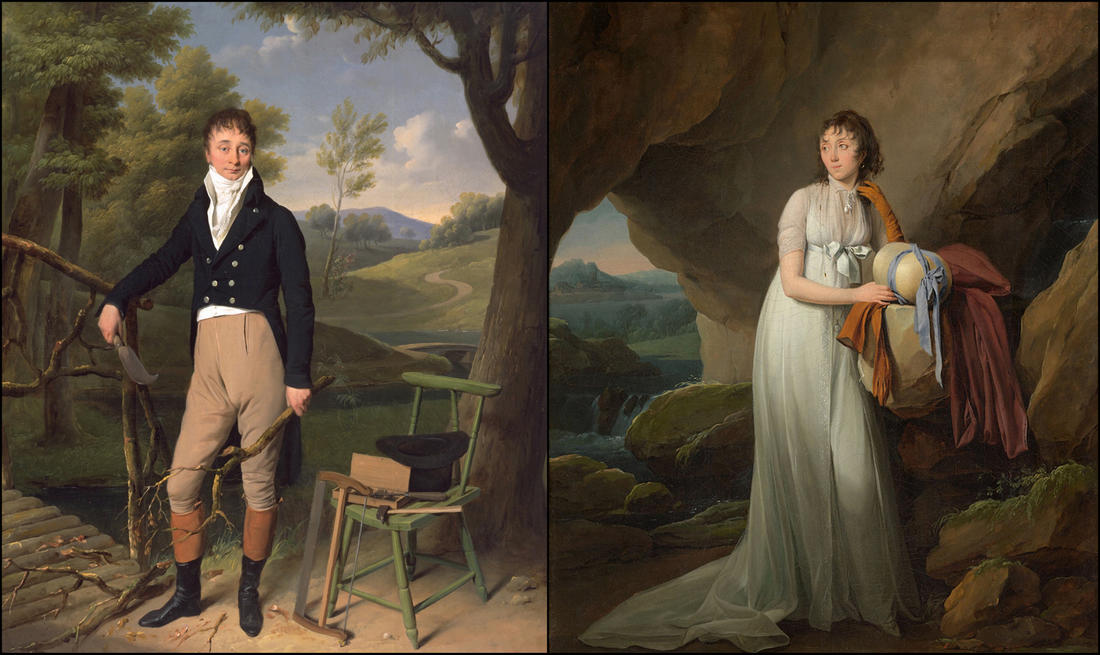On the one hand, we have the elegantly dressed man, tools in hand. On the other, a woman in an immaculate chiffon dress, taking shelter in a cave as if seeking to flee something or someone. This staging does not correspond to any reality, but instead to a fashionable effect.
Boilly succumbed to the veritable anglomania that swept France, directly inspired by British painters like Reynolds or Gainsborough. The countryside, the cave, the small stream and the falling light make up the small romantic theatre of this posing session. Delacroix returns to this same setting for his Medea, also exhibited in Lille.
Again, Boilly applies the codes of neo-classicism: studied poses, harmony of colour and precision of drawing. He seeks elegance, to the detriment of realism. What mastery he presents in the rendering of fabrics, and what refinement in his details: the delicate foliage or the top hat on the one hand, the crystal medallion, the gold earrings or the blue ribbon of the hat on the other.
What matters is that the social position of those represented is conveyed. The man is active. He holds a sickle in one hand and a branch in the others. He looks as though he has been interrupted in his work repairing the small bridge behind him. The woman, on the other hand, is languid. Her gaze is distant and melancholic. She has taken off her hat, glove and cape. Despite the incongruity of these two scenes, they both appear to be in communion with nature.
Painter, illustrator, engraver and cartoonist, Louis-Léopold Boilly was born in 1761 in La Bassée, in the Nord department. He moved to Paris in 1785 and became, thanks to his genre paintings and gallant scenes, an excellent chronicler of Parisian life at that time. Highly realistic and usually small in format, his portraits – a sort of precursor to our modern identity photos – were vital to his success.

On the one hand, we have the elegantly dressed man, tools in hand. On the other, a woman in an immaculate chiffon dress, taking shelter in a cave as if seeking to flee something or someone. This staging does not correspond to any reality, but instead to a fashionable effect.
Boilly succumbed to the veritable anglomania that swept France, directly inspired by British painters like Reynolds or Gainsborough. The countryside, the cave, the small stream and the falling light make up the small romantic theatre of this posing session. Delacroix returns to this same setting for his Medea, also exhibited in Lille.
Again, Boilly applies the codes of neo-classicism: studied poses, harmony of colour and precision of drawing. He seeks elegance, to the detriment of realism. What mastery he presents in the rendering of fabrics, and what refinement in his details: the delicate foliage or the top hat on the one hand, the crystal medallion, the gold earrings or the blue ribbon of the hat on the other.
What matters is that the social position of those represented is conveyed. The man is active. He holds a sickle in one hand and a branch in the others. He looks as though he has been interrupted in his work repairing the small bridge behind him. The woman, on the other hand, is languid. Her gaze is distant and melancholic. She has taken off her hat, glove and cape. Despite the incongruity of these two scenes, they both appear to be in communion with nature.
Painter, illustrator, engraver and cartoonist, Louis-Léopold Boilly was born in 1761 in La Bassée, in the Nord department. He moved to Paris in 1785 and became, thanks to his genre paintings and gallant scenes, an excellent chronicler of Parisian life at that time. Highly realistic and usually small in format, his portraits – a sort of precursor to our modern identity photos – were vital to his success.